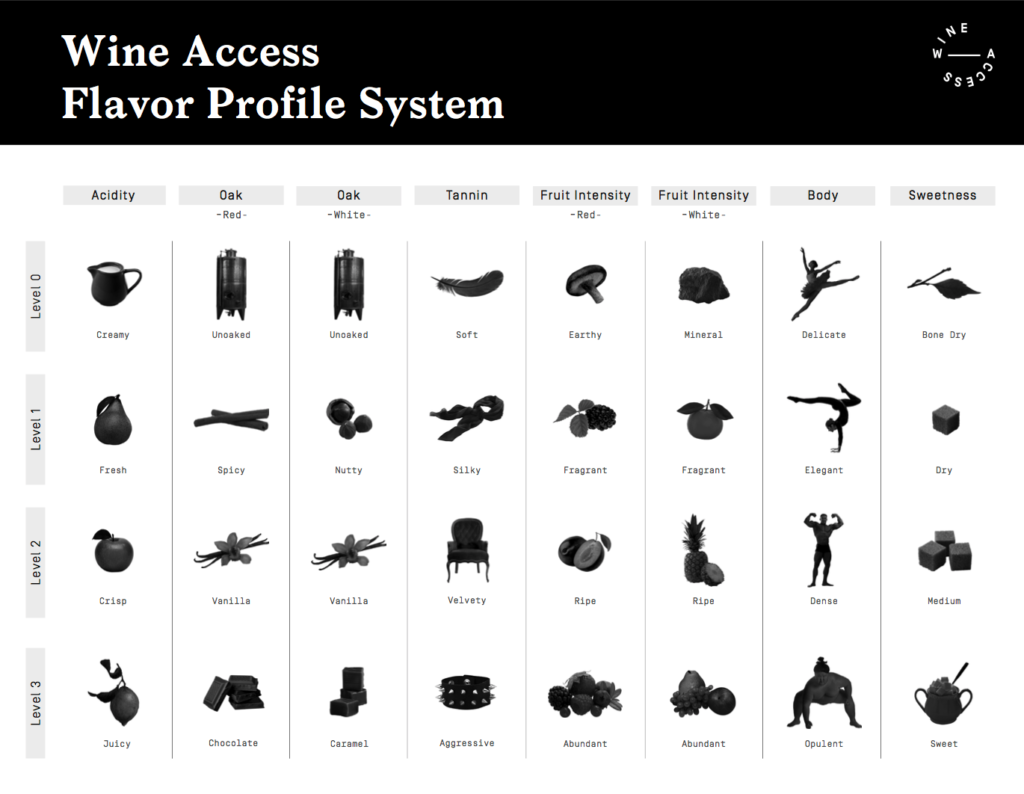by Jonathan Cristaldi
You may not realize it, but the language you use for tasting wine often includes the same words you use to describe other things you consume every day, such as coffee, chocolate, or berries. It’s also important to remember that none of us have the same tasting experience; your experience of “fruity” might dramatically differ from someone else’s. We’ve identified six descriptors that will help you understand and talk about wine: “Fruity,” “Acidic,” “Oaky,” “Tannic,” “Sweet,” and “Body.” Below, we break down what these words mean and how to use them so you can better recognize your wine preferences.

Our Master Wine Team has identified six main attributes of a wine that can be defined by four varying levels of intensity. While there are many different factors that can impact the way a wine tastes, the six components listed below are the most consistent. Learning about these will not only help you identify what you like about certain wines, but it can also help you discover new wines. We’re not exactly suggesting that you memorize the suggestions below, but if anything, they’ll help get you started on talking like the wine pro you always knew you could be.
To boot, we’ve further decoded our Wine Access flavor profiles and scoring system, but here’s an overview and guide to help you master the art of talking through these six attributes of a wine:
ACIDITY
Acids are one of the four things that our tongues can taste along with bitterness, saltiness, and sweetness. When tasting acidity in wine, think of the soft acids of milk at one end of the spectrum and lemon juice at the other end, with infinite variation in between.

Say it about high acid: “This wine has mouthwatering acidity! It’s like biting into a freshly picked lemon and it makes your mouth salivate!”
Say it about low acid: “This wine is creamy with soft acidity. It’s like taking a gulp of a glass of whole milk!”
OAK
Wines with no oak tend to be fresh, fruity, floral. As the level of new–oak influence increases, you begin to taste subtle baking spices, grilled nuts, and vanilla, all the way through to chocolate and caramel in the oakiest of wines.


Say it about an unoaked red: “This is an incredibly fruity wine, showing bright berry flavors and no oakiness!”
Say it about a heavily-oaked red: “I really love the rich, spicy oak flavors in this red — they remind me of cinnamon and baking spices.”
TANNIN
Tannins provide structure to both red and white wines, though more obviously in red wines as they are invariably fermented in contact with skins, seeds, and sometimes stems. Tannin is the drying effect on the finish, similar to when drinking tea.

Say it about a slightly-tannic wine: “This is a really juicy wine, and is quite soft with very little tannin structure.”
Say it about a heavily-tannic wine: “Wow! I can feel the grittiness and my mouth is drying out from the heavy, robust tannins in this red.”
FRUITY
The ripeness and intensity of fruit for each wine depends on climate, grape variety, and the stylistic choices of the winemaker — particularly the harvest date. Fruit intensity and ripeness can be detected both on the nose in terms of fruit aroma, and on the palate in terms of fruit richness and fleshiness.


Say it about a fruity white wine: “I really love the citrusy notes I’m smelling, and after tasting can really notice the tart lemon-flavors on the palate, which are even a bit creamy!”
Say it about a fruity red wine: “I really love the bright red berry aromas, which, after tasting the wine becomes darker, and more like blackberry or black cherry fruit.”
BODY
The overall weight of the wine in the mouth. Think of the difference in palate weight between the different types of milks, with lightest bodied wines as having the body of fat free milk and the fullest bodied wines the weight of whole milk.

Say it about a light-bodied white wine: “This is a brilliant white, and its crisp and mineraly and in the mouth feels a lot like skim milk — almost airy and ethereal in texture. I love it!”
Say it about a full-bodied red wine: “You have to try this! It’s just unbelievably rich, and weighty, like taking a big gulp of whole milk — or even chocolate milk — and it’s totally hedonistic and delicious.”
SWEETNESS
Like acidity, sweetness is a taste that can be perceived by the tongue. Sweetness can be balanced by other components in the wine, particularly acid and tannin, so sweetness can be cloying or help smooth out the wine, depending on the overall balance.

Say it about an off-dry (almost imperceptibly) sweet wine: “Oh, this is good. There’ just a hint of sweetness on the tip of my tongue, but there’s lots of juicy acidity to keep it lively and fresh.”
Say it about a fully sweet white wine: “This is unreal! It’s just everything you ever wanted in a dessert wine — it’s rich and unctuous and viscous and beautifully sweet, like the best 3-Michelin-Star dessert you’ve ever had, only liquified!”
And there you have it. For practicality’s sake, the wines curated in our Wine Access store each include a flavor profile to help you understand the complexities of the wine. These flavor profiles provide a deeper understanding of each wine so you can pinpoint the attributes you enjoy in wine. And with this guide, you can really know (or at least sound like you know) what you’re talking about when you’re talking about a wine.






